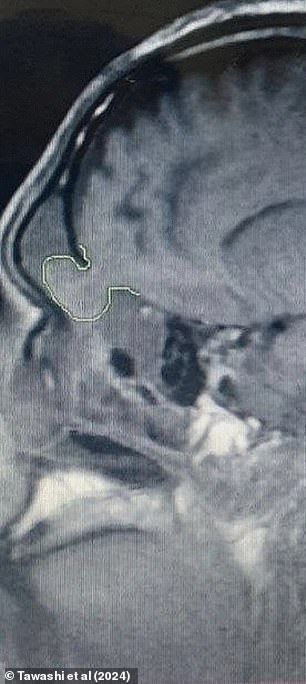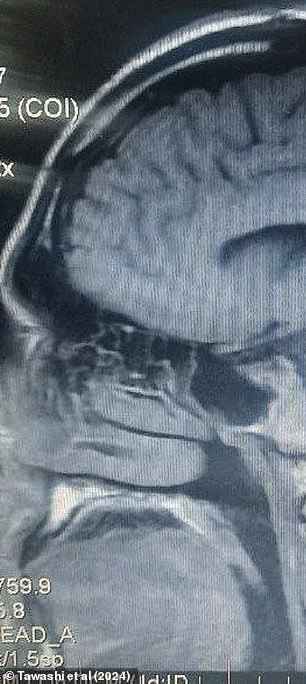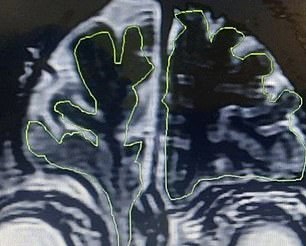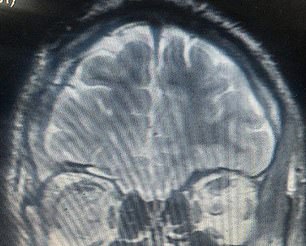The runny nose a 20-year-old man had been suffering from for six years turned out to be his brain bulging through a hole in his skull.
The unidentified man, of Syrian origin, was suffering from chronic runny nose, headaches and seizures after sustaining a head injury.
What he thought was simply a cold symptom was actually a “leak” of cerebrospinal fluid (CSF), a clear fluid that protects the brain and spinal cord.
The problem began after the patient suffered a traffic accident six years earlier, in which he sustained a head injury, but refused medical treatment at the time. From then on he began to suffer from moderate headaches and seizures, as well as a runny nose.
The anonymous 20-year-old patient had been experiencing cerebrospinal fluid leakage for six years (file photo)
After taking images of the man’s brain, doctors diagnosed him with traumatic encephalocele, a condition in which brain matter leaks through openings in the skull, such as the nasal cavity.
In most cases, an encephalocele is a rare birth defect that causes the tissue covering the brain, and possibly parts of the brain itself, to protrude through openings in the skull.
The birth defect occurs in about one in every 10,400 births, or about 375 babies a year.
In some cases, however, people may develop a traumatic encephalocele after experiencing some type of trauma or injury to the head or brain, and the condition may develop years after the initial injury if the patient refuses treatment.
Because the condition is so rare, there are no figures available on how many traumatic encephaloceles occur in the U.S. each year.
However, one study A nasal encephalocele, like the one the 20-year-old had, is estimated to occur in one of every 40,000 live births in the United States each year.
According to the Syrian patient Case reportBetween 10 and 30 percent of skull base fractures develop CSF leak.
CSF leakage can impair the brain’s blood supply and function. It also increases the risk of brain injury because CSF acts as a protective cushion for the organ.
Any type of encephalocele is treated with surgery to repair the tear and close any open layers to ensure that no more tissue or brain matter can drain out of the skull.
In the case of the Syrian patient, the man refused initial treatment for his injuries when he was taken to the hospital after his car accident.
After suffering from headaches and seizures for years, the man developed meningoencephalitis two months before he presented to the hospital with CSF leaking from his nose.
He was admitted to the intensive care unit for a month and underwent an MRI of his brain.
This examination revealed that he had a fractured skull and an encephalocele had developed in his nasal cavity.
Her brain tissue and meninges (layers that protect the brain and spine) were protruding through the skull fracture with “significant expansion” into areas on the right side of the brain filled with CSF.


The image on the left shows the man’s encephalocele in his nasal cavity and the image on the right shows the resolution of the man’s encephalocele in his nasal cavity after surgery.


The image on the left shows the encephalocele that has passed through the patient’s skull into his nasal cavity and the image on the right shows the patient’s brain after the encephalocele has been removed.
Doctors recommended surgery to repair the fracture, but the patient refused medical attention.
When she returned to the hospital two months later for a follow-up, another MRI showed the same thing and she was again recommended surgery.
The patient eventually relented and underwent an operation in which a neurosurgeon returned the tissue and matter that had leaked through the patient’s nasal cavity to their normal locations.
The doctor also repaired the damaged meninges and reconstructed the base of the skull where the fracture had damaged it with medical-grade cement and glue.
The patient recovered well and was sent home two days later.
At a follow-up visit two months later, an MRI revealed that the patient’s encephalocele was completely closed and that any damage the bulging matter had had on the brain and surrounding areas had been reversed.
The man also stopped having headaches, runny nose and seizures.
Doctors in the case report cautioned that although a traumatic encephalocele is “a rare and unexpected complication of trauma,” doctors should evaluate patients “because of its potentially life-threatening consequences.”


